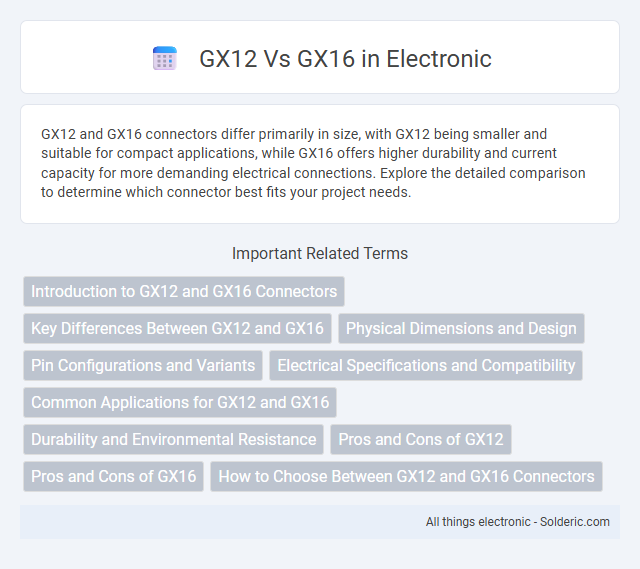GX12 and GX16 connectors differ primarily in size, with GX12 being smaller and suitable for compact applications, while GX16 offers higher durability and current capacity for more demanding electrical connections. Explore the detailed comparison to determine which connector best fits your project needs.
Comparison Table
| Feature | GX12 | GX16 |
|---|---|---|
| Connector Diameter | 12mm | 16mm |
| Number of Pins | 2 to 12 | 2 to 12 |
| Current Rating | 5A | 10A |
| Voltage Rating | Up to 250V | Up to 250V |
| Application | Small devices, sensors | Industrial equipment, power connections |
| Durability | Moderate | High |
| Weight | Lighter | Heavier |
| Common Use | Audio equipment, lighting | Motors, heavy machinery |
Introduction to GX12 and GX16 Connectors
GX12 and GX16 connectors are circular aviation connectors widely used in industrial and electronic applications for secure cable connections. GX12 connectors typically feature 3 to 7 pins and a diameter of 12mm, while GX16 connectors offer 3 to 7 pins but have a larger 16mm diameter, allowing for higher current capacity and enhanced durability. Choosing the right connector ensures reliable signal transmission and fits your device's size and power requirements.
Key Differences Between GX12 and GX16
GX12 and GX16 connectors differ primarily in their size and pin configurations, with GX12 typically featuring 12mm diameter shells and fewer pins, while GX16 has a larger 16mm diameter and supports more pins for complex connections. The increased pin count and shell size of GX16 connectors offer enhanced current capacity and durability, making them suitable for more demanding industrial applications compared to the more compact and lightweight GX12 counterparts. Your choice between GX12 and GX16 should consider the required electrical load, space constraints, and the specific application's robustness needs.
Physical Dimensions and Design
The GX12 connector features a compact design with a 12mm diameter, making it ideal for applications requiring smaller electrical connections. In contrast, the GX16 connector measures 16mm in diameter, providing a sturdier build suitable for higher current demands and more rugged environments. Your choice between GX12 and GX16 should consider the available space and desired durability in the device's design.
Pin Configurations and Variants
GX12 connectors typically feature 3 to 7 pins, making them suitable for applications requiring fewer connections, while GX16 connectors range from 3 to 19 pins, offering broader functionality for complex wiring needs. Variants of GX12 prioritize compact design and lightweight usage, whereas GX16 variants emphasize higher durability and increased electrical contacts for industrial-grade performance. Your choice between GX12 vs GX16 should depend on the number of pins required and the specific demands of your electronic or automation project.
Electrical Specifications and Compatibility
The GX12 and GX16 connectors differ primarily in size and current rating, with GX12 supporting up to 5A and GX16 handling up to 10A, making GX16 suitable for higher power applications. Both connectors share similar voltage ratings, typically around 250V, but the GX16's larger diameter ensures better durability and compatibility with thicker cables. Despite their differences, GX12 and GX16 connectors maintain compatible pin configurations, allowing for straightforward integration in varied electronic and industrial equipment setups.
Common Applications for GX12 and GX16
GX12 and GX16 connectors are widely used in aviation, industrial equipment, and LED lighting systems, where reliable electrical connections are essential. GX12 connectors, with a smaller diameter and fewer pins, are often employed in compact devices such as small drones, sensors, and audio equipment. GX16 connectors, featuring a larger size and higher pin count, are preferred for heavier-duty applications including industrial machinery, motor controllers, and professional audio equipment due to their enhanced durability and capacity.
Durability and Environmental Resistance
GX12 connectors offer strong durability with robust metal housing and solid contact pins suitable for standard industrial environments. GX16 connectors enhance environmental resistance by incorporating thicker metal casing and improved sealing, providing superior protection against dust, moisture, and mechanical stress. Both types deliver reliable performance, but GX16 connectors are preferable for harsher conditions demanding higher durability and environmental resilience.
Pros and Cons of GX12
The GX12 connector offers a compact size ideal for applications with limited space, providing a reliable and secure connection for electrical components. Its smaller diameter results in lighter weight and easier handling, but this comes at the cost of lower current and voltage ratings compared to the larger GX16, limiting its use in high-power environments. However, the GX12 is often favored for low to moderate power devices due to its cost efficiency and ease of installation.
Pros and Cons of GX16
GX16 connectors offer robust durability and higher current capacity compared to smaller GX12 models, making them ideal for heavy-duty industrial applications. Their larger size enables easier handling and better mechanical stability but can result in increased space requirements and slightly higher costs. GX16 connectors provide reliable performance in demanding environments but may be less suitable for compact or lightweight electronic devices.
How to Choose Between GX12 and GX16 Connectors
Choosing between GX12 and GX16 connectors depends primarily on the current and voltage requirements of your application. GX12 connectors are smaller, typically supporting currents up to 5A and voltages around 250V, making them ideal for compact electronic devices with moderate power needs. Your selection should consider the physical size constraints and electrical specifications, with GX16 connectors offering higher current capacity (up to 7A) and more robust durability for heavier industrial or audio equipment.
GX12 vs GX16 Infographic

 solderic.com
solderic.com